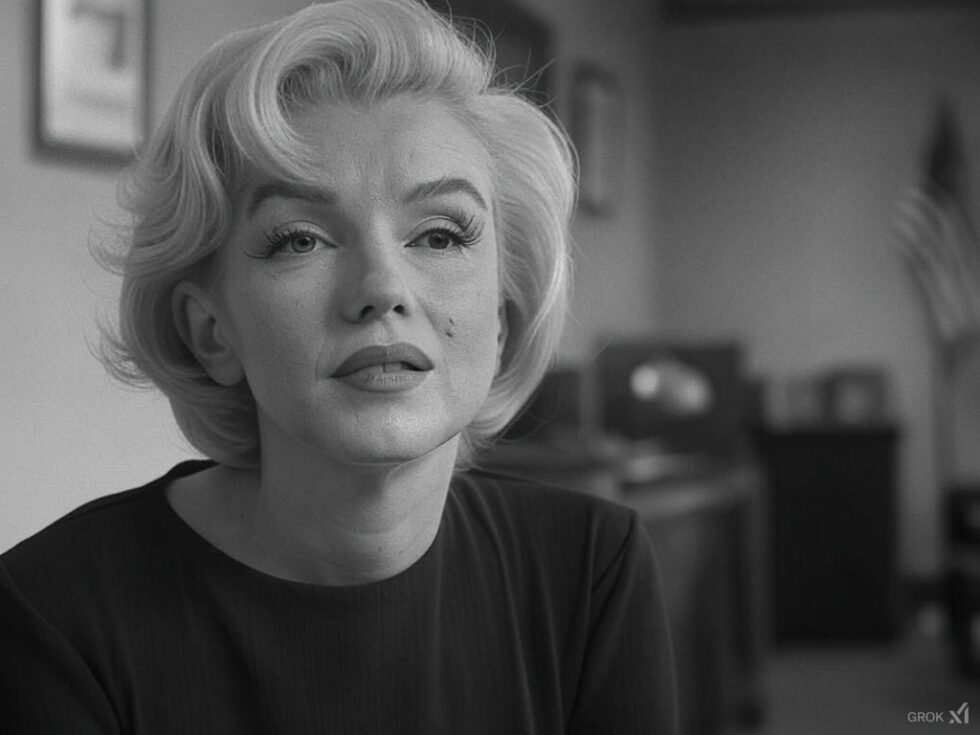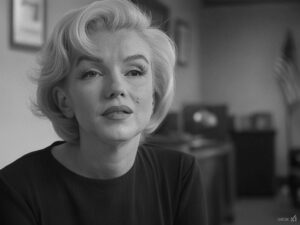
In the shimmering glow of Hollywood’s golden age, Marilyn Monroe stood as an icon, her image immortalized in the minds of millions. Yet, in this alternate timeline, the tragic events of 1962 never transpired. Instead, Monroe continued to captivate the world, with her life taking unexpected turns that would ripple through the decades.
As the 1960s progressed, Monroe’s career evolved. No longer content with roles that typecast her as the quintessential blonde bombshell, she sought more substantial and varied parts. Her determination led her to collaborate with innovative directors and writers who recognized her depth and potential. In 1964, she starred in the groundbreaking film “The Silent Echo,” a poignant drama about a woman’s struggle with identity and mental health. Her performance was lauded by critics and audiences alike, earning her an Academy Award for Best Actress. This victory marked a turning point, not just for Monroe, but for Hollywood itself, as it began to embrace more complex female characters.
Beyond the silver screen, Monroe became an influential figure in the burgeoning feminist movement. Her personal experiences with the industry’s sexism and her own struggles with self-worth resonated with the public. She used her platform to advocate for women’s rights, speaking out against the exploitation and objectification rampant in Hollywood. In 1966, she co-founded the “Women in Film” organization, which aimed to support and empower women in the industry. Her involvement lent the movement visibility and legitimacy, helping drive significant changes, including the implementation of more equitable hiring practices and the creation of roles that portrayed women as multifaceted individuals.

As Monroe’s influence grew, so did her interest in politics. Encouraged by friends and contemporaries, she began to engage with social issues beyond the entertainment world. Her friendship with civil rights leaders like Martin Luther King Jr. and her vocal support for racial equality made her a beloved figure across diverse communities. In 1968, she made headlines when she participated in the Poor People’s Campaign, marching alongside activists in Washington, D.C. Her presence brought global attention to the cause, highlighting the intersection of poverty, race, and gender.
In the 1970s, Monroe’s life took yet another unexpected turn. Embracing the era’s spirit of self-discovery and transformation, she explored new artistic avenues. She took up photography, capturing candid moments of her travels and encounters with people from all walks of life. Her work was celebrated for its authenticity and empathy, earning her exhibitions in renowned galleries worldwide. Monroe also penned a memoir, “Reflections of a Star,” which offered an introspective look into her life, fame, and the personal battles she had overcome. The book became a bestseller, further cementing her status as a cultural icon.
As the years passed, Monroe’s legacy continued to evolve. In the 1980s, she became a mentor to a new generation of actresses, guiding them through the challenges of fame and encouraging them to use their voices for change. Her advocacy for mental health awareness, informed by her own experiences, led to the establishment of the Marilyn Monroe Foundation, which funded research and provided support for those struggling with mental illness.
By the time the 1990s arrived, Monroe was revered not just as a cinematic legend, but as a trailblazer who had used her fame to effect meaningful change. Her life was celebrated in documentaries and biographies, and she was frequently invited to speak at universities and conferences, where she shared her insights on the intersection of art, activism, and personal growth.
In this alternate history, Marilyn Monroe’s enduring presence had a profound impact on society. Her journey from Hollywood starlet to influential advocate and artist inspired countless individuals to pursue their passions and fight for justice. Her story became a testament to the power of resilience and the potential for transformation, reminding the world that even the brightest stars can shine in unexpected and lasting ways.




